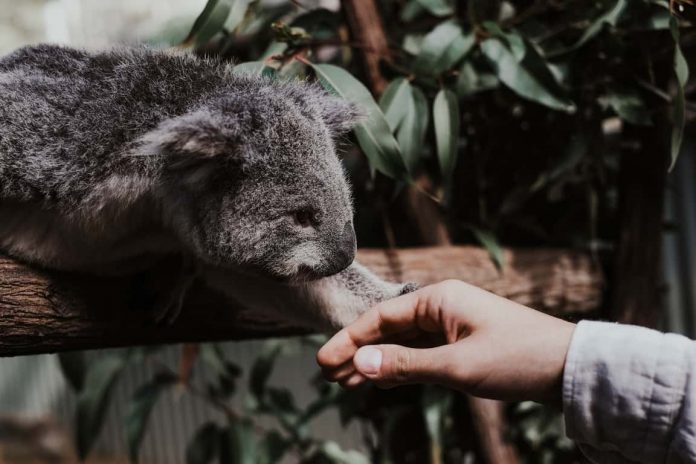
Koalas are illegal to pet
There you have it: You can’t legally own a koala, no matter how adorable and cuddly you find them to be. It is illegal to keep Koalas under your ownership in any part of the world, including Australia and the US, and for all the good reasons. Koalas have recently been added to the Red List of species. They lie under the ‘vulnerable to extinction’ category due to constant poaching, killing for the fur, and destruction of their natural habitat.
In the early 1900s, Koalas were driven to the verge of extinction due to an alarming surge in their hunting for fur. However, with constant efforts, the Koala population has significantly increased. But wait- this doesn’t mean there are a lot of them in Australia; the Australian Koala Foundation provided with an estimate that suggested there are possibly as few as only 43,000 koalas now left in the world.
It is illegal to even hold a koala
Koalas are solitary animals, and they do not like much human interaction. The Australian State of New South Wales and most others comprising the Koala population prohibit visitors of the zoo from holding a koala. Koalas have a natural fear of humans, and they feel stressed upon introduction to human interaction. Therefore most states have made it illegal for people to hold Koalas in the zoo.
Queensland and a few other states allow visitors to contact Koalas; however, all of this is under the supervision and care of a keeper of the zoo. So, if you are visiting a zoo in Queensland, be careful and pay utmost attention to the Koala’s comfort while holding that adorable baby.
Koalas have an inflexible diet
Even if you can manage to own a koala legally (which you can’t), you will never be able to handle the Koala’s diet unless you plan to starve it (to death). Koalas feed exclusively on Australia’s native trees- the eucalyptus and some other trees native to Australia, which means they have a pretty inflexible diet.
This is just the start of being picky since koalas don’t just eat only eucalyptus, but they are also highly selective about the eucalyptus species they eat. Even after choosing what species of eucalyptus to eat, they choose certain individual plants among those species, so yes, koalas are the pickiest eaters of Australia.
Did you think you could easily arrange 500-800 grams of eucalyptus leaves (the amount Koala eats in a day) since it’s not a big deal at all? Well, now you know how big a deal it is. And if you are wondering that maybe you could plant a few eucalyptus trees in your backyard, good luck with that.
You will have to plant at least hundreds of them (and about 30 different eucalyptus species that koalas prefer to eat) so that the Koala may choose a few from those. Seems impossible, right? So is your pursuit to pet a koala!
In addition to eucalyptus, the koalas can occasionally be found to eat Acacia leaves, paperback leaves, and leaves of Melaleuca, Callitris, Allocasuarina, and Leptospermum.
Koalas stink of urine (and eucalyptus oil)
An adult koala stinks of urination and cough drop, which is gross. It’s not hard to understand why the Koala may smell so. Eucalyptus oil is most commonly used in cough drops due to its anti-inflammatory properties that come from a compound called cineole- and what do koalas eat? Right, eucalyptus leaves. Other than eating, koalas mostly dwell on eucalyptus trees to avoid predators.
Since they are tree dwellers, koalas don’t care about where they pee (usually on trees they live on), which makes them stink of urine and eucalyptus oil, and you probably won’t be able to stand the stench for too long.
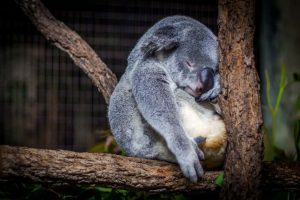
Koalas sleep all the time
It’s a known fact koalas sleep for about 18-22 hours a day, and this unusual sleeping habit of the koalas, unlike all marsupials and herbivores, is linked to their eating habits and digestive system. Koalas feed on a staple diet of highly toxic eucalyptus leaves, have little to almost no nutritional value, with negligible energy (as calories) to fuel the Koala’s body. Eucalyptus is also hard to digest since it’s very high in fiber, so even if it weren’t poisonous, no other herbivore would eat it anyway.
Thus, koalas have to conserve energy to digest the highly fibrous leaves by slowing down their metabolism rate- and what better way to slow down the metabolism than lying down static, hugging their favorite trees, and finally getting lulled into a deep sleep for 18 hours straight. This allows the Koala to let their digestive system burn down and extract the limited nutrition from the eucalyptus leaves and allow the toxins to be expelled from their body.
They wake up to eat again from the same eucalyptus tree (about 1000 leaves a day), then cradle back to sleep. All of their monotonous life revolves around these two activities- so it is pretty much invalid a point to keep them as pets because they’ll never really be able to play with you or at least be awake.
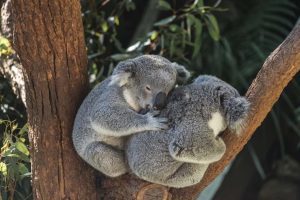
Koalas rest on only certain trees
Koalas stay on the ground for a very short time, and they never sleep on the ground so, if you could ever pet a koala in your home, you’d have to plant a lot of those high and tall trees native to Australia. But wait, that’s just one side of the story; apart from living only on trees, koalas live on certain trees, and a group of these individual trees make up the koalas’- ‘Home Trees.’
Change in the Koala’s habitat can negatively impact it
Koalas may be solitary, but they tend to live in societies with each Koala having a ‘Home Range’ that often overlaps with the other koalas.’ Like humans, they need to come into contact with other koalas, and for this to happen, there must be suitable eucalyptus forests that can support them and their population. Change in a koala’s habitat can deeply negatively impact its health because they may not meet other koalas, in turn, feeling stressed.
And as mentioned before, Koalas can’t live without feeding on eucalyptus leaves, so; if you’re petting a koala and do not feed it its favorite snack, you are ultimately starving the creature to death. Other than this, changing a koala’s habitat (including change in the weather conditions) can also impact koalas.
They can’t live in too hot places, so they do not occupy the northern parts of Queensland, where temperatures scale up to 120 degrees Fahrenheit (48.9 Celcius). Koalas are more comfortable in cooler weather, and they are highly sensitive to heat.
Koalas are wild and can be dangerous
No matter how much you tame a koala, it’s still built for life outdoors. They have sharp teeth that are strategic adaptations overtime to nip and chew the leathery eucalyptus leaves- the teeth are sharp enough to pierce human flesh and make you bleed, so beware! The powerful jaws pack a punch, and combined with sharp teeth, a vigorous bite to humans is a piece of cake for a koala.
The zoo koalas haven’t been reported to scratch or nip at humans. However, you should never attempt to hold a wild one- they will not think for a second before giving you some impressive scratches on the face to let you show your friends. If you do nothing about the scratches, they might as well go septic and make it complicated for your health.
Koalas are territorial animals, so if you’re thinking of petting a wild one that you just rescued, think twice. They feel threatened upon human intervention and can go ‘ninja-mode’ if they think there’s a need to. The ‘ninja’ koalas can be aggressive, following you long distances to chase you away while belching at you, rarely attacking.
Koalas aren’t friendly to pets or humans
Koalas aren’t friendly to humans or our pets, either. No, don’t cry in a corner; hear us out first: koalas aren’t to be blamed when it comes to why they don’t like human intervention in their lives; it is basically how they are designed.
Koalas feel stressed upon unwanted handling
Koalas aren’t teddy bears- they are wild animals that are shy and relatively tame who do not see us as their friends. Koalas do not like to be handled by humans, and unwanted handling causes them stress. They release cortisol- a stress hormone in response to an undesired and unwanted stimulus, including handling by humans. Male koalas seem to be more stressed upon unwanted handling than females unless they are lactating.
What do Koalas do when stressed? A wild Koala, if annoyed and touched incessantly, may try to attack you, but it’ll only be mild; however, a pet koala (the ones in zoos) will become more vigilant. When stressed, Koalas stare at you nervously, which may be funny for us but considering the low-energy levels of koalas, it can be highly detrimental for them.
What effect does stress have on Koalas? It’s just stress; how bad can it be? Right? Well, for koalas, stress negatively impacts its health. As animals with extremely low energy, stress can be an ‘energy-costly’ mechanism that affects koalas’ foetal development.
Other than that, increased stress means koalas have to spend much longer time digesting their food since all the time they spent sleeping to conserve energy and digest food just went into vain. Even noisy surroundings can put a koala under stress, so when you visit a zoo, make sure not to coo, call them over or get too touchy with them.
If you can’t hold a koala, we think it’s pretty invalid to keep them as pets at all since, no matter how adorable they are, you can’t cuddle with them for their own sake.
Koalas are prone to catching Chlamydia
It seems that Koalas are particularly vulnerable to catching chlamydia (a sexually transmitted disease) rather than any other animal, and researchers aren’t completely sure why. Surveys show that some koala populations may have an infection rate ranging from anywhere near 80-100%.
Most of the time, chlamydia goes untreated, leading to the blinding of koalas, kidney failure, and cancer. They also experience excruciating pain due to the expansion of the urinary bladder. The pain can be so severe that the areas surrounding the tract wall can slough off, causing the Koala’s death. Yes, that’s how bad it can be.
But antibiotics must be able to help, right? It’s not as simple as it is for humans. Yes, the antibiotics do help, but in the end, it’s more harm to koalas than it’s good. How? After receiving treatment, koalas profusely lose weight, and some die soon after, even though they completely recover from the disease.
We know that eucalyptus forms the staple of a koala’s diet, which has a highly toxic compound known as tannin. This tannin is broken down by the gut bacteria of koalas, which allows these creatures to feed on more eucalyptus and survive. The drugs that act as antibiotics to treat the koalas interfere and upset their gut diversity, slowing down or hindering the digestive abilities of the Koala’s gut. If the antibiotics kill the microbes in the Koala’s gut, they may get poisoned from constant feeding on the highly toxic eucalyptus.
Note: No significantly effective vaccine can cure chlamydia in koalas. Recently, scientists have developed a vaccine that can help female koalas suffering from chlamydia to a great extent.
Koalas may also transmit chlamydia to humans
There are pretty high chances that you can get infected with chlamydia through a koala. How? Well, the Koala’s adorable gestures and looks play the part here. Like most marsupials, koalas don’t care about where they exactly pee, and when you hold an infected koala, trying to be all cuddly, it may pee on you. When this happens, there may be a transmission of the chlamydia strain to the human (you, if you’re petting it).
In men, it can cause swelling and intense pain in the testis when urinating or during intercourse. It is more severe in women and can lead to severe complications if left untreated, such as permanent damage to the reproductive system.
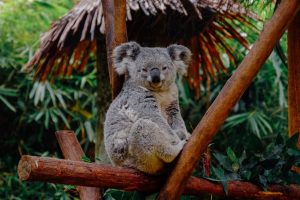
What Can You Do To Save Koalas?
Koalas are in danger from not just being hunted by dogs, cats, or being hit by cars or chlamydia- their home is on the verge of destruction with Koalas continually being in trouble. Forests in Australia are disappearing at a shocking rate, which greatly affects the koalas- the constant reports of wildfires don’t help either. The biggest threat to koalas is climate change, and scientists predict that if we do nothing about the surging deteriorative effects on climate, Koalas may not exist at all in the next 30 years.
We ask you to help these little buddies and be a part of the change, but how can you help koalas? Donate to the koala hospitals, wildlife parks, and rehabilitation centers in Australia. Myriad GoFundMe accounts help you make the necessary donations that are used by organizations and structures to help recover injured and diseased koalas. These donations that you make will also help ensure that the koalas get a stable home without the threat of having to move from one place to the other.
The Koala habitat is getting destroyed for all the bad reasons, so whenever you go on a trip to Australia (especially parts where Koalas live), plant a Koala’s food tree in enough fertile soil so that you can help save their habitat from destruction. Several organizations, such as the Australian Koala Foundation, help you plant these trees for the koalas.
When you visit a zoo, refrain from holding a koala or from being too loud- this is the best method to maintain the Koala’s good health. Apart from these, spread the word, create awareness about them, and you can help save the koalas from going extinct.
Myths about Koalas
Myth: Koalas are slow
Debunked: Koalas do sleep most of the time and are not involved in too many activities, but this doesn’t mean they are slow. The Koalas are surprisingly fast, agile, and powerful animals, who can run at a speed of 20mph, and these skillful climbers can leap up trees in 2-meter spurts.
Myth: Koalas get high on eucalyptus
Debunked: This is the most popular myth about Koalas. Eucalyptus does not contain alcohol and is intoxicating to them; it has low nutritional value and takes a lot of energy to digest. Hence, the Koalas sleep for 18-20 hours a day to conserve their energy to digest food and not due to hangovers.
Myth: Koalas feed on only eucalyptus leaves
Debunked: Though the Koalas have high preferences for eucalyptus trees, there are many other gum trees like blue gums, yellow gums, sugar gums, ironbarks, manna gums, red box, and some other native trees of Australia that Koalas feed on.
Myth: Koalas are close to bears in the Animal Kingdom
Debunked: Surprisingly, there are no similarities between the Koalas and the bears other than the fluffy fur. Koalas belong to the marsupials category, and they are in no way linked to bears either genetically or behaviorally.
Koalas look like small bears with those big beady eyes, a cute button nose, and all that fur, but surprisingly they are just mammals with downward pouches (animals with pouches are marsupials) to develop their immature children, unlike bears that are placental mammals.
Myth: Koalas love to be petted, cuddled and are docile
Debunked: Koalas are solitary animals, and they experience stress when humans get closer to them. Hence prefer no human contact.
A minimum 10 meters of distance is found to be the closest you should ever be to the Koalas. When we approach closer to Koalas, they stop resting or feeding and stare at you nervously. A Koala may enjoy being petted but only by their wildlife caretakers who raised them.
Myth: Koalas are highly populated, and you’ll find them everywhere in Australia
Debunked: The effect of habitat destruction, bushfires and road accidents have brought the Koalas to the age of extinction, and around 5,000 Koalas were killed in Australia’s bushfires. The International Union for Conservation of Nature added Koalas to the Red List of species at risk due to climatic changes.
Myth: Koalas are drop bears that attack and kill humans.
Debunked: It’s thought that Koalas are drop bears who jump on you from over the trees and attack you. It’s actually funny to think of something like that, but in reality, koalas are pretty calm and peace-loving animals who love their solitary space and would never really jump on you to attack and kill you, if that’s what you’re wondering.
However, koalas drop sometimes: during extreme heat, koalas get easily dehydrated, which weakens them, and as a result, they may faint and fall to the ground (it’s sad and awful). However, we’ve never heard of them accidentally falling on humans.
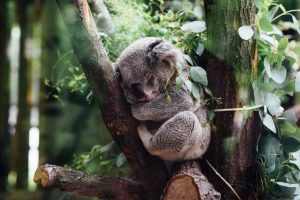
Interesting Facts About Koalas
1.) Koalas can be found in Southeastern and eastern Australia: Koalas are an intrinsic part of Australia’s culture. Unlike the mainstream notion that Koalas are found all over Australia, they are usually found in only the southeastern and eastern parts of Australia.
2.) Koala Bears aren’t actually bears: The Koalas are marsupial animals who carry their young once in a pouch as the Kangaroos do. They may share resemblance with bears and look like toy bears, but they aren’t.
3.) Koalas have a grooming tool: Koalas have an adaptive evolution that allows them to comb their long fur. How? The first and the second toes of the Koalas are fused together- they have two claws as well, which combined together aid in combing their fur.
4.) Koalas have individual fingerprints: The Koalas belong to the set of mammals that have fingerprints, and sometimes it’s difficult to distinguish between fingerprints of a Koala and a human.
5.) Koalas have a supporting butt: The Koalas rump (rear end) is densely packed with fur, which acts as a cushion, and cartilage over the curved spines provides them more padding so that they can survive easily on high up on eucalyptus trees.
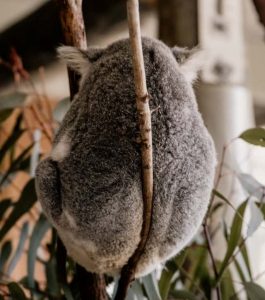
6.) Koalas drink water: In Dharug, an Australian Aboriginal language, the word “Koala” means “no water,” and based on this, it was believed that Koalas don’t drink water. Most of the moisture that they get is indeed derived from the gum trees that have large amounts of water, but they do drink water from different sources during heatwaves and in times of drought when the water content of eucalyptus is insufficient.
7.) Baby Koalas are called “Joeys”: A Joey, when born, is 2 cm long, blind, and furless given birth to by young koala females during the breeding seasons. Joey stays about 6-7 months in their mother’s pouch and drinks only milk until they are fully mature to step out in the world.
8.) Koalas have a unique digestive organ: Caecum is a specialized fiber-digestive organ that helps them digest toxic eucalyptus leaves by detoxifying it. Although the caecum is present in humans too, the caecum in Koalas is really long, as long as about 200 cms, which is why koalas can digest the high amount of fiber in the eucalyptus diet without any difficulties.
9.) Koalas sniff and use their nose to recognize their friends and enemies: Koalas have special nasal abilities, and they use their big black soft to the touch leathery nose to smell the plant toxins. They have certain enzymes expressed in the linings of the nose, which helps them detoxify the plant toxins. Other than this, the Koalas use their nose to communicate and make friends.
FAQs
How do Koalas catch chlamydia?
Well, just like humans, adult koalas catch chlamydia through sexual transmission but wait, what about the young koalas? The young koalas catch chlamydia too, not because they are already copulating, but the reason is generally linked to coprophagia (eating stools of their own or others).
Young koalas eat the pap or stool of their mothers, which is nutritious and incorporates a lot of bacteria that is required for them to digest the food that’s hard to break down in the digestive system. Now, you koalas eat the pap of their mothers that maybe and quite often are infected, thus transmitting chlamydia to their young ones.
Why do Koalas prefer to eat only certain species of Eucalyptus leaves?
Currently, there are about 600-700 species of eucalyptus trees, out of which koalas prefer to eat only 30 species. The reason is simple- eucalyptus leaves are much devoid of any nutrition, and they are too high in fiber. However, these 30 species preferred by koalas have higher amounts of protein in comparison to the rest with less lignin and fiber, which is hard to digest.
To name a few species of eucalyptus, Koalas love to eat; they are Eucalyptus tereticornis and Eucalyptus microcorys, etc. At least 20% of the Koala’s diet is made of the leaves of two tree leaves, including Eucalyptus camaldulensis.
How do Koalas climb trees?
The long and sharp claws of koalas are of primary assistance when it comes to climbing tree trunks. You may have noticed that they have curled hands. However, they have curled feet too, which helps them hold or hug the tree better. Additionally, each hand has two opposable thumbs, and what do they do? They provide a better grip to the Koala for climbing trees.
Why do Koalas usually stay on trees?
Koalas are pretty tame animals that do not like violence unless provoked; thus, they are often in danger from other wild animals, including wild dogs, cats, and others. Since they have low energy levels (they aren’t slow, however) and weigh only 4-15 kilograms at the most with a small size averaging between 70-90 cms, they aren’t exactly built for a fight. Staying on the ground means being vulnerable to attack. Thus koalas, with their long claws and ability to climb high, usually spend their time on trees.
How long do Koalas live?
It depends on where the Koala lives. If the Koala lives in the wild, in its natural surroundings, without catching chlamydia (which greatly reduces their lifespan), Koalas can live from 15-18 years. In captivity, due to less availability of eucalyptus leaves and much more stress to handle on a daily basis (due to human interaction and high levels of noise), Koalas can live up to 15 years and sometimes more.
Sources
- 10 Facts About Koalas!, National geographic kids.
- Koala, Save the koala.






